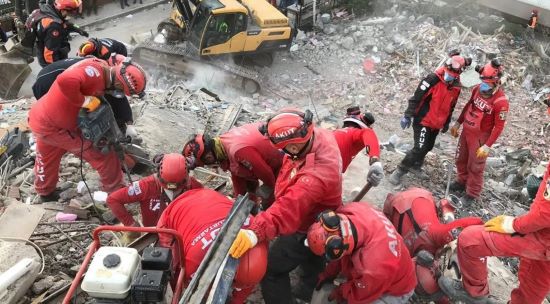A huge earthquake killed more than 3,700 people across a swathe of Turkey and northwest Syria on Monday, with freezing winter weather adding to the plight of the many thousands left injured or homeless and hampering efforts to find survivors.
The magnitude 7.8 quake brought down whole apartment blocks in Turkish cities and piled more devastation on millions of Syrians displaced by years of war.
The worst tremor to strike Turkey this century came before sunrise in harsh weather and was followed in the early afternoon by another large quake of magnitude 7.7.
“It was like the apocalypse,” said Abdul Salam al-Mahmoud, a Syrian in the northern town of Atareb. “It’s bitterly cold, heavy rain, and people need saving.”
The second quake was big enough to bring down more buildings and, like the first, was felt across the region, endangering rescuers struggling to pull casualties from the rubble.
In Diyarbakir in southeast Turkey, a woman speaking next to the wreckage of the seven-story block where she lived said: “We were shaken like a cradle. There were nine of us at home. Two sons of mine are still in the rubble; I’m waiting for them.”
She was nursing a broken arm and had injuries to her face.
The earthquake was the biggest quake recorded worldwide by the US Geological Survey since a tremor in the remote South Atlantic in August 2021.
In Turkey, the death toll stood at 2,316, the Disaster and Emergency Management Authority (AFAD) said, making it the country’s deadliest earthquake since a tremor of similar magnitude in 1999 devastated the heavily populated eastern Marmara Sea region near Istanbul, killing more than 17,000.
Poor internet connections and damaged roads between some of the worst-hit cities in Turkey’s south, homes to millions of people, hindered efforts to assess and address the impact.
Temperatures in some areas were expected to fall to near freezing overnight, worsening conditions for people trapped under rubble or left homeless. In addition, rain fell on Monday after snowstorms swept the country at the weekend.
It is already the highest death toll from an earthquake in Turkey since 1999. A tremor of similar magnitude devastated the heavily populated eastern Marmara Sea region near Istanbul, killing more than 17,000.
More than 13,000 people were injured in Turkey by the quake.
President Tayyip Erdogan, preparing for a tough election in May, called it a historical disaster and the worst earthquake to hit Turkey since 1939 but said authorities were doing all they could.
“Everyone is putting their heart and soul into efforts, although the winter season, cold weather and the earthquake happening during the night makes things more difficult,” he said.
Turkish state broadcaster TRT showed a building collapse in the southern province of Adana after the second quake. It was not immediately clear if it was evacuated.
At least 1,444 people were killed in Syria in Monday’s quake, and about 3,500 were injured, according to figures from the Damascus government and rescue workers in the northwestern region controlled by insurgents.
The Norwegian Refugee Council said the earthquake would only add to the suffering of millions of Syrians already enduring a humanitarian crisis due to the civil war.
In the Turkish city of Diyarbakir, Reuters journalists saw dozens of rescue workers searching through a mound of debris; all that was left of a big building, and hauling off bits of wreckage as they looked for survivors. Occasionally they raised their hands and called for quiet, listening for sounds of life.
Men carried a girl wrapped in blankets from a collapsed building in the city. In Izmir, drone footage showed rescue workers standing atop a hill of rubble where a building once stood, working to lift slabs of masonry.
Footage on Twitter showed two neighboring buildings collapsing one after the other in Syria’s Aleppo, filling the street with billowing dust.
Two residents of the city, which has been heavily damaged in the war, said the buildings had fallen in the hours after the quake, which was also felt in Cyprus and Lebanon.
‘No one came out.’
In the Syrian rebel-held town of Jandaris in Aleppo province, a mound of concrete, steel rods and bundles of clothes lay where a multi-story building once stood.
“There were 12 families under there. Not a single one came out. Not one,” said a thin young man, his eyes wide open in shock and his hand bandaged.
Raed al-Saleh of the Syrian White Helmets, a rescue service in the rebel-held territory known for pulling people from the ruins of buildings destroyed by air strikes, said they were in “a race against time to save the lives of those under the rubble.”
In the Syrian government-held city of Hama, a Reuters journalist saw a lifeless child carried from the ruins of a building.
Syrian state television showed rescue teams searching for survivors in heavy rain and sleet. President Bashar al-Assad held an emergency cabinet meeting to review the damage and discuss the next steps, his office said.
Erdogan said 45 countries had offered to help with the search and rescue efforts in Turkey.
In the Turkish city of Malatya, a rescue worker crawled into a collapsed building, trying to identify a survivor trapped under the wreckage, in footage released by Turkey’s Disaster and Emergency Management Authority (AFAD).
“What color are you wearing? Are you wearing pink? Please take care of yourself for the moment; I cannot see anything else,” the rescue worker could be heard saying. (Reuters)






